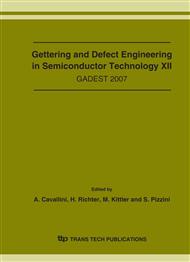p.357
p.363
p.369
p.375
p.381
p.387
p.393
p.399
p.405
Radiation Enhanced Diffusion of Implanted Palladium in Silicon
Abstract:
Low-temperature diffusion of palladium (450–700 oC) from an implanted layer (9.5 MeV, 1⋅1013cm-2) deep into the volume of a high-power P-i-N diode (2.5kV, 150A) is compared with that of a sputtered palladium layer (50nm thick), both under the enhancement by the radiation defects from He2+ implantation (10 MeV, 1⋅1012cm-2). Annealing after the palladium implantation (800oC, 60min.) prior to the He2+ implantation is shown to increase the concentration of palladium related deep levels in the damaged region with a subsequent improvement of diode dynamic parameters. The concentration of palladium in-diffusing from the implanted layer with the dose of 1⋅1013cm-2 does not sufficiently reduce excess carrier lifetime close to the anode junction as is the case of the devices with sputtered palladium that give better dynamic parameters like lower maximal reverse recovery current and recovery losses for the same magnitude of leakage current.
Info:
Periodical:
Pages:
381-386
Citation:
Online since:
October 2007
Authors:
Keywords:
Price:
Сopyright:
© 2008 Trans Tech Publications Ltd. All Rights Reserved
Share:
Citation:


